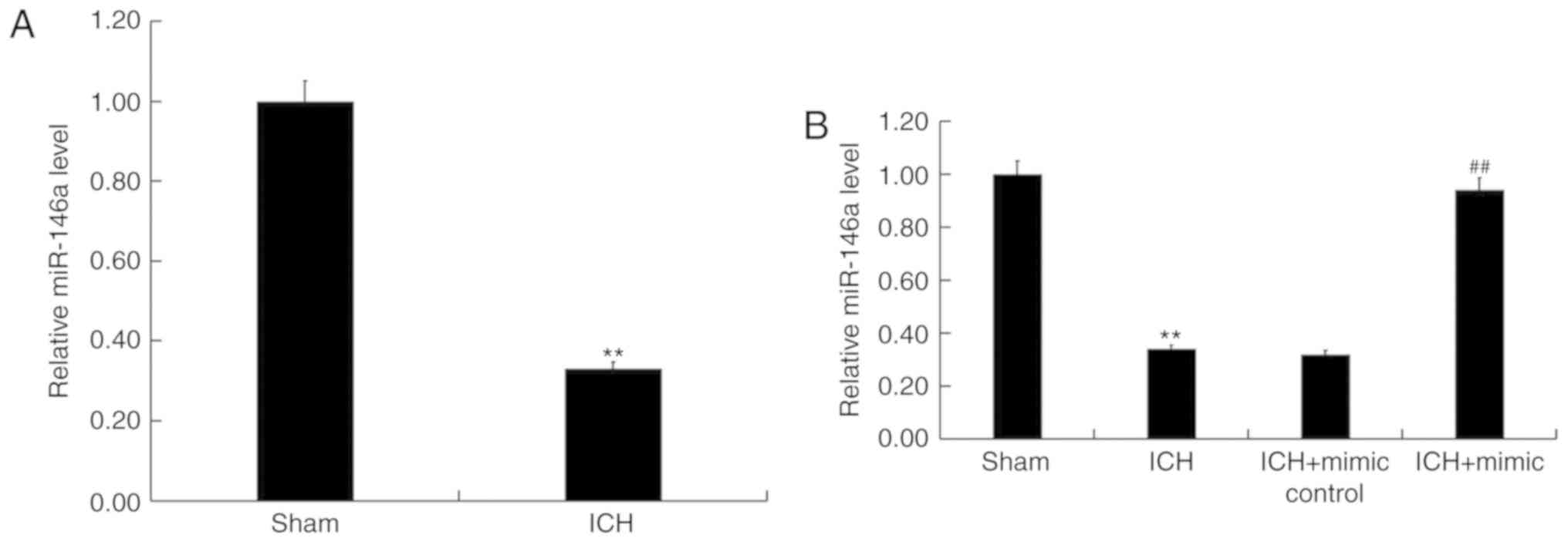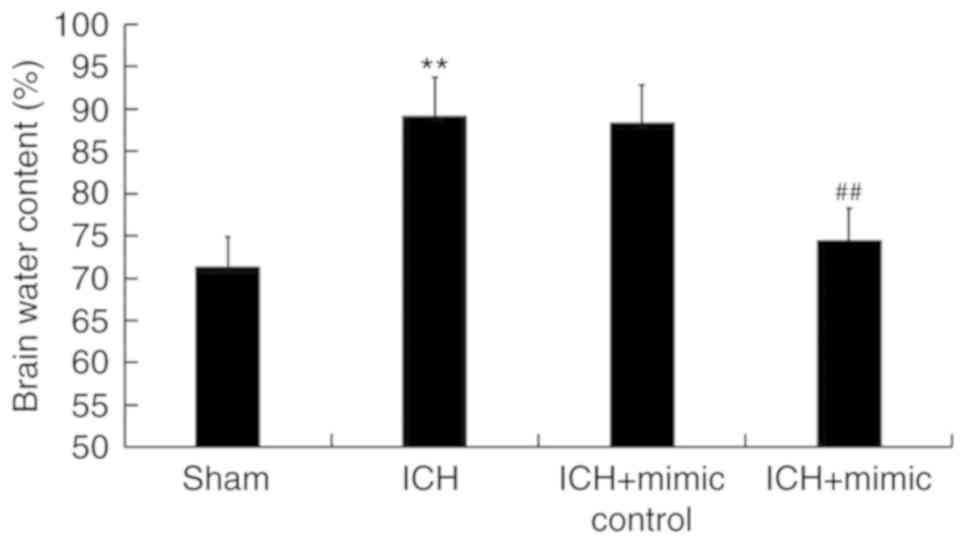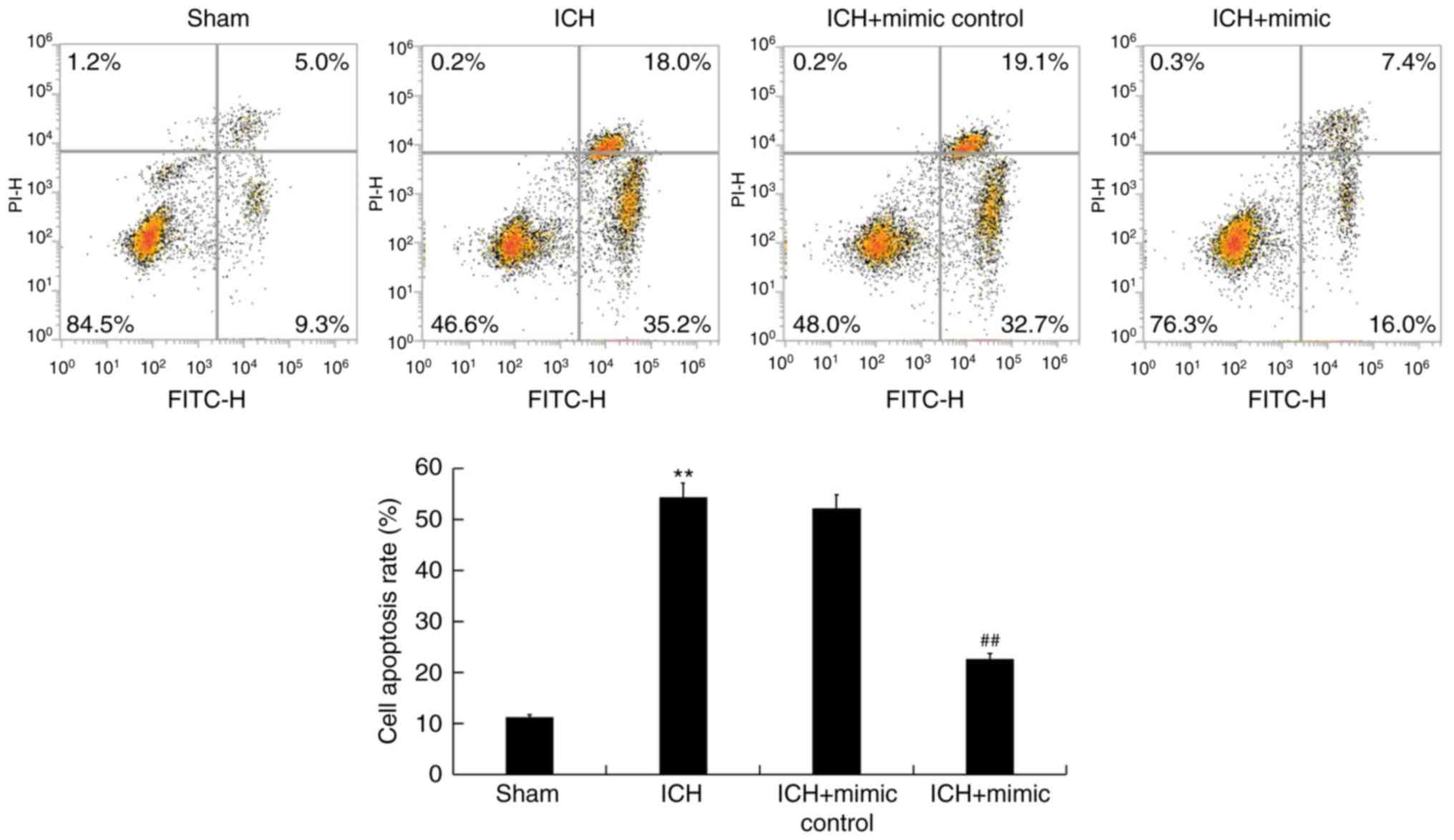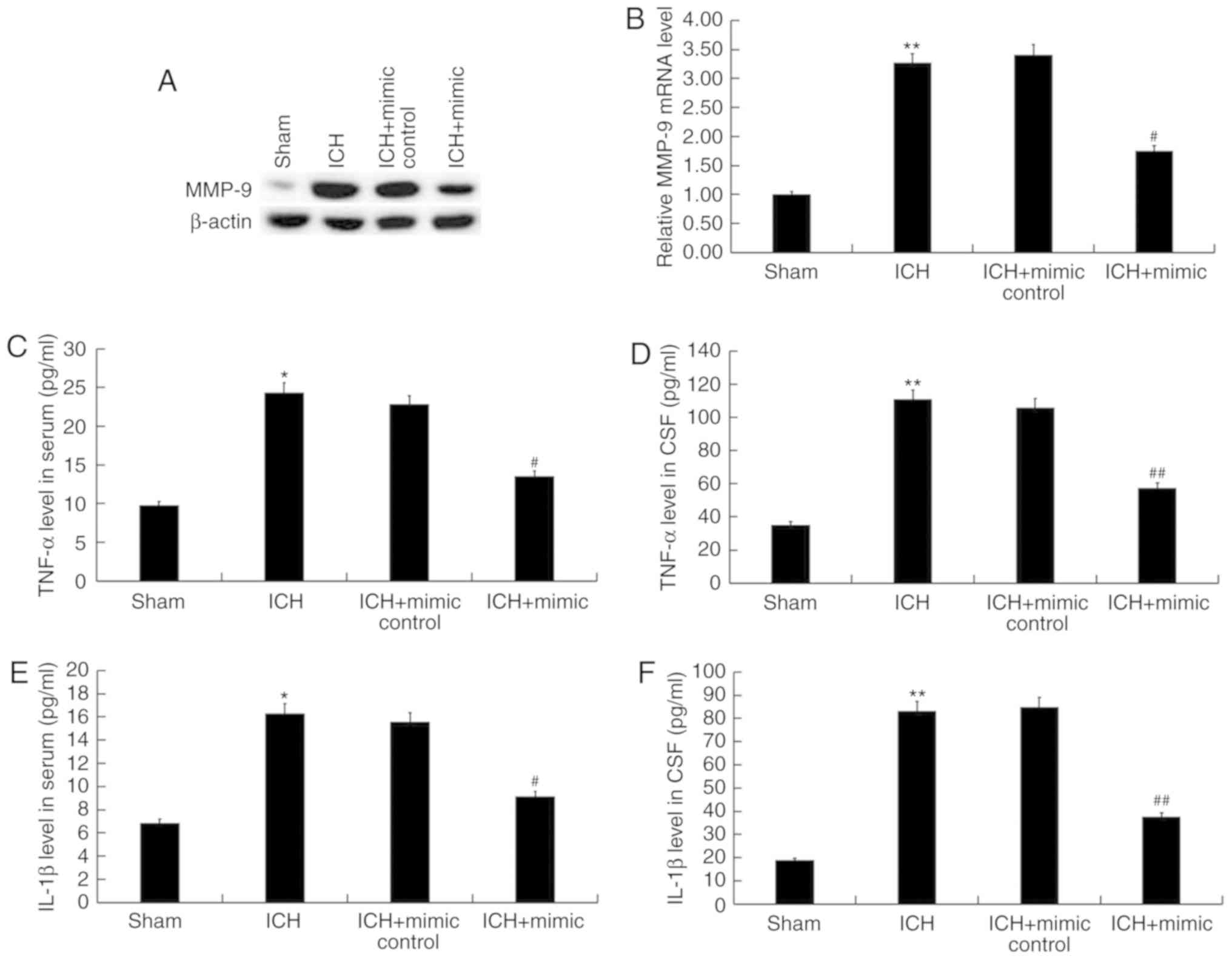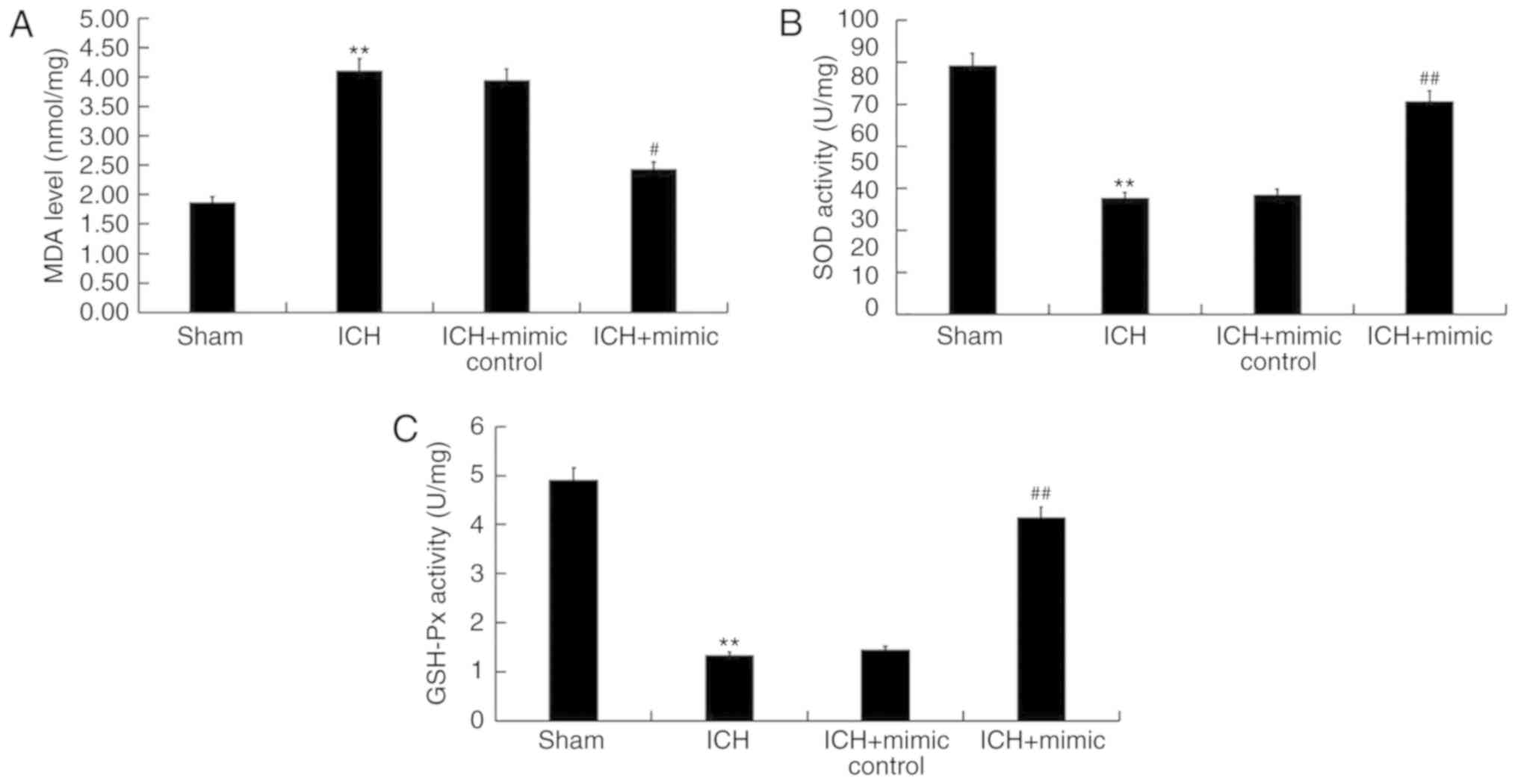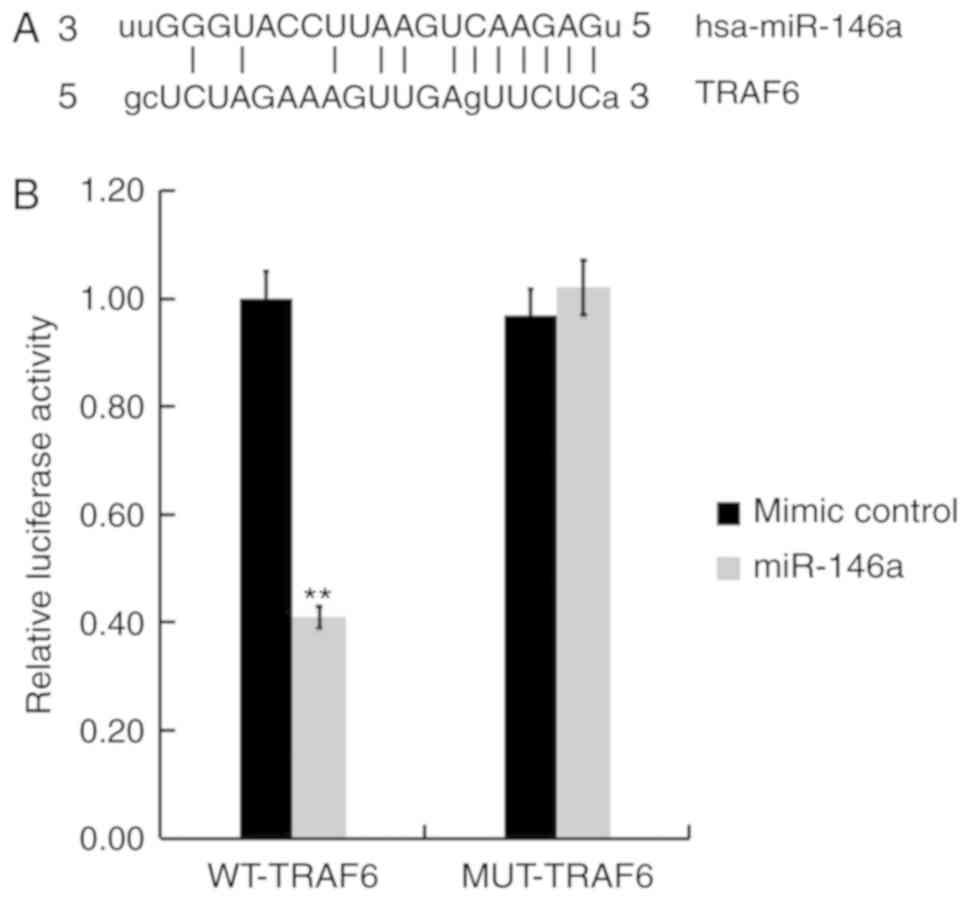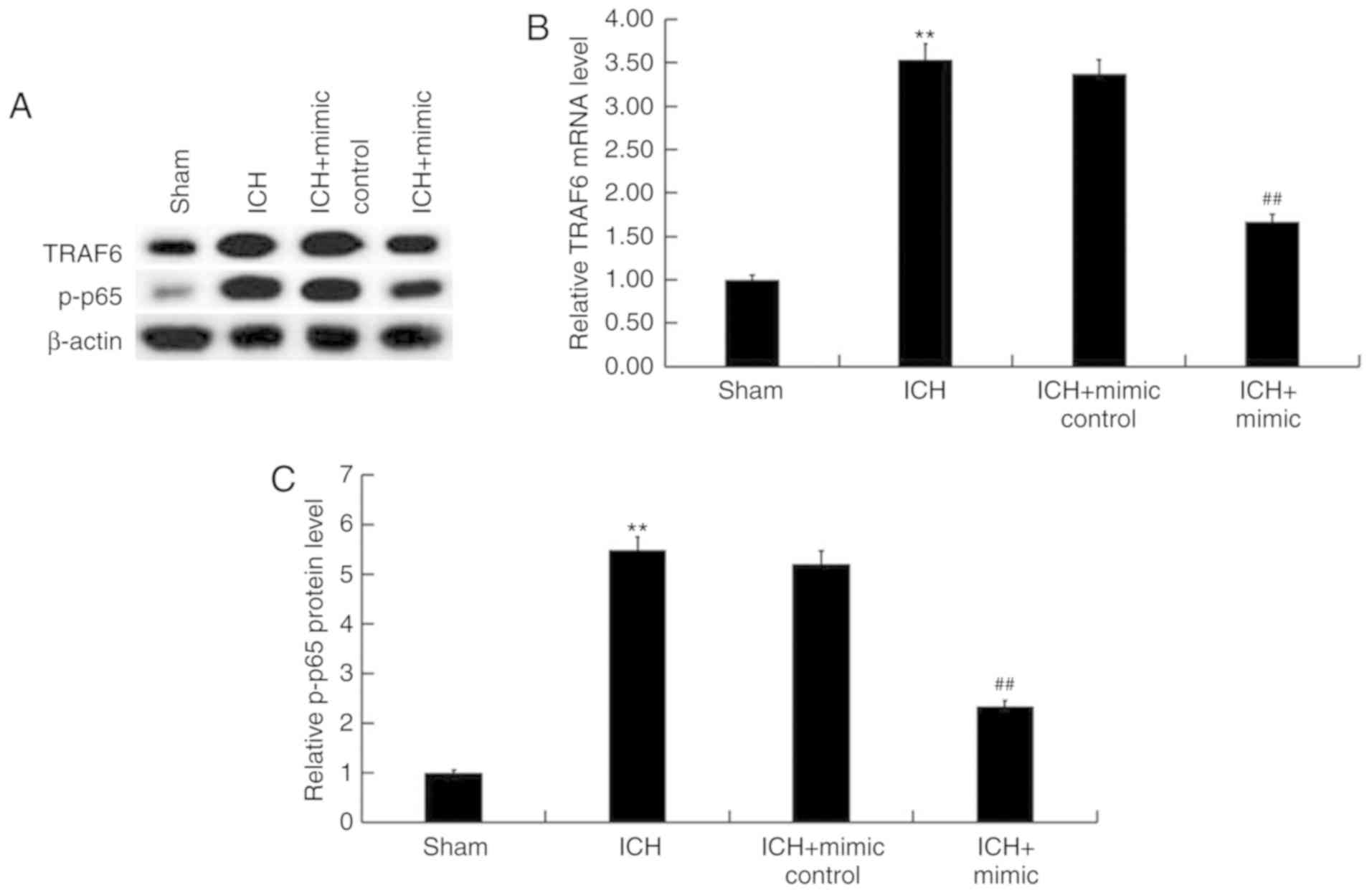|
1
|
Liu L, Wang D, Wong KS and Wang Y: Stroke
and stroke care in China: Huge burden, significant workload and a
national priority. Stroke. 42:3651–3654. 2011. View Article : Google Scholar : PubMed/NCBI
|
|
2
|
Donnan GA, Fisher M, Macleod M and Davis
SM: Stroke. Lancet. 371:1612–1623. 2008. View Article : Google Scholar : PubMed/NCBI
|
|
3
|
Qureshi AI, Mendelow AD and Hanley DF:
Intracerebral hemorrhage. Lancet. 373:1632–1644. 2009. View Article : Google Scholar : PubMed/NCBI
|
|
4
|
Huttner HB and Kuramatsu JB: Current
treatment concepts in intracerebral hemorrhage. Med Klin
Intensivmed Notfmed. 112:695–702. 2017.(In German). View Article : Google Scholar : PubMed/NCBI
|
|
5
|
Levi M, Levi JH, Andersen HF and Truloff
D: Safety of recombinant activated factor VII in randomized
clinical trial. N Engl J Med. 363:1791–1800. 2010. View Article : Google Scholar : PubMed/NCBI
|
|
6
|
Xi G, Keep RF and Ho JT: Mechanisms of
brain injury after intracerebral haemorrhage. Lancet Neurol.
5:53–63. 2006. View Article : Google Scholar : PubMed/NCBI
|
|
7
|
Boulouis G, van Etten ES, Charidimou A,
Auriel E, Morotti A, Pasi M, Haley KE, Brouwers HB, Ayres AM,
Vashkevich A, et al: Association of key magnetic resonance imaging
markers of cerebral small vessel disease with hematoma volume and
expansion in patients with lobar and deep intracerebral hemorrhage.
JAMA Neurol. 73:1440–1447. 2016. View Article : Google Scholar : PubMed/NCBI
|
|
8
|
Gong C, Boulis N, Qian J, Turner DE, Hoff
JT and Keep RF: Intracerebral hemorrhage-induced neuronal death.
Neurosurgery. 48:875–882. 2001. View Article : Google Scholar : PubMed/NCBI
|
|
9
|
Wang J: Preclinical and clinical research
on inflammation after intracerebral hemorrhage. Prog Neurobiol.
92:463–477. 2010. View Article : Google Scholar : PubMed/NCBI
|
|
10
|
Hammond SM: An overview of microRNAs. Adv
Drug Deliv Rev. 87:3–14. 2015. View Article : Google Scholar : PubMed/NCBI
|
|
11
|
Soifer HS, Rossi JJ and Saetrom P:
MicroRNAs in disease and potential therapeutic applications. Mol
Ther. 15:2070–2079. 2017. View Article : Google Scholar
|
|
12
|
Krol J, Loedige I and Filipowicz W: The
widespread regulation of microRNA biogenesis, function and decay.
Nat Rev Genet. 11:597–610. 2010. View
Article : Google Scholar : PubMed/NCBI
|
|
13
|
O'Connell RM, Rao DS, Chaudhuri AA and
Baltimore D: Physiological and pathological roles for microRNAs in
the immune system. Nat Rev Immunol. 10:111–122. 2010. View Article : Google Scholar : PubMed/NCBI
|
|
14
|
Iwuchukwu I, Nguyen D and Sulaiman W:
MicroRNA profile in cerebrospinal fluid and plasma of patients with
spontaneous intracerebral hemorrhage. CNS Neurosci Ther.
22:1015–1018. 2016. View Article : Google Scholar : PubMed/NCBI
|
|
15
|
Wang J, Zhu Y, Jin F, Tang L and He Z and
He Z: Differential expression of circulating microRNAs in blood and
haematoma samples from patients with intracerebral haemorrhage. J
Int Med Res. 44:419–432. 2016. View Article : Google Scholar : PubMed/NCBI
|
|
16
|
Zhu Y, Wang JL, He ZY, Jin F and Tang L:
Association of altered serum MicroRNAs with perihematomal edema
after acute intracerebral hemorrhage. PLoS One. 10:e01337832015.
View Article : Google Scholar : PubMed/NCBI
|
|
17
|
Guo D, Liu J, Wang W, Hao F, Sun X, Wu X,
Bu P, Zhang Y, Liu Y, Liu F, et al: Alteration in abundance and
compartmentalization of inflammation-related miRNAs in plasma after
intracerebral hemorrhage. Stroke. 44:1739–1742. 2013. View Article : Google Scholar : PubMed/NCBI
|
|
18
|
Liang R, Li Y, Wang M, Tang SC, Xiao G,
Sun X, Li G, Du N, Liu D and Ren H: MiR-146a promotes the
asymmetric division and inhibits the self-renewal ability of breast
cancer stem-like cells via indirect upregulation of Let-7. Cell
Cycle. 17:1445–1456. 2018. View Article : Google Scholar : PubMed/NCBI
|
|
19
|
Tan Y, Yu L, Zhang C, Chen K, Lu J and Tan
L: miRNA-146a attenuates inflammation in an in vitro spinal
cord injury model via inhibition of TLR4 signaling. Exp Ther Med.
16:3703–3709. 2018.PubMed/NCBI
|
|
20
|
An R, Feng J, Xi C, Xu J and Sun L:
miR-146a attenuates sepsis-induced myocardial dysfunction by
suppressing IRAK1 and TRAF6 via targeting ErbB4 expression. Oxid
Med Cell Longev. 2018:71630572018. View Article : Google Scholar : PubMed/NCBI
|
|
21
|
Han S, Ma C, Bao L, Lv L and Huang M:
miR-146a mimics attenuate allergic airway inflammation by impacted
group 2 innate lymphoid cells in an ovalbumin-induced asthma mouse
model. Int Arch Allergy Immunol. 177:302–310. 2018. View Article : Google Scholar : PubMed/NCBI
|
|
22
|
Nguyen LS, Fregeac J, Bole-Feysot C,
Cagnard N, Iyer A, Anink J, Aronica E, Alibeu O, Nitschke P and
Colleaux L: Role of miR-146a in neural stem cell differentiation
and neural lineage determination: Relevance for neurodevelopmental
disorders. Mol Autism. 9:382018. View Article : Google Scholar : PubMed/NCBI
|
|
23
|
Chu B, Zhou Y, Zhai H, Li L, Sun L and Li
Y: The role of microRNA-146a in regulating the expression of IRAK1
in cerebral ischemia-reperfusion injury. Can J Physiol Pharmacol.
96:611–617. 2018. View Article : Google Scholar : PubMed/NCBI
|
|
24
|
Arena A, Iyer AM, Milenkovic I, Kovacs GG,
Ferrer I, Perluigi M and Aronica E: developmental expression and
dysregulation of miR-146a and mir-155 in down's syndrome and mouse
models of down's syndrome and Alzheimer's disease. Curr Alzheimer
Res. 14:1305–1317. 2017. View Article : Google Scholar : PubMed/NCBI
|
|
25
|
Sison SL, Patitucci TN, Seminary ER,
Villalon E, Lorson CL and Ebert AD: Astrocyte-produced miR-146a as
a mediator of motor neuron loss in spinal muscular atrophy. Hum Mol
Genet. 26:3409–3420. 2017. View Article : Google Scholar : PubMed/NCBI
|
|
26
|
Luo Q, Ren Z, Zhu L, Shao Y, Xie Y, Feng
Y, Li B and Chen Y: Involvement of microRNA-146a in the
inflammatory response of s tatus epilepticus rats. CNS Neurol
Disord Drug Targets. 16:686–693. 2017. View Article : Google Scholar : PubMed/NCBI
|
|
27
|
Cao Z, Xiong J, Takeuchi M, Kurama T and
Goeddel DV: TRAF6 is a signal transducer for interleukin-1. Nature.
383:443–446. 1996. View
Article : Google Scholar : PubMed/NCBI
|
|
28
|
Lomaga MA, Yeh WC, Sarosi I, Duncan GS,
Furlonger C, Ho A, Morony S, Capparelli C, Van G, Kaufman S, et al:
TRAF6 deficiency results in osteopetrosis and defective
interleukin-1, CD40 and LPS signaling. Genes Dev. 13:1015–1024.
1999. View Article : Google Scholar : PubMed/NCBI
|
|
29
|
Dou Y, Tian X, Zhang J, Wang Z and Chen G:
Roles of TRAF6 in central nervous system. Curr Neuropharmacol.
16:1306–1313. 2018. View Article : Google Scholar : PubMed/NCBI
|
|
30
|
Zhong JH, Li J, Liu CF, Liu N, Bian RX,
Zhao SM, Yan SY and Zhang YB: Effects of microRNA-146a on the
proliferation and apoptosis of human osteoarthritis chondrocytes by
targeting TRAF6 through the NF-κB signalling pathway. Biosci
Rep. 37(pii): BSR201605782017. View Article : Google Scholar : PubMed/NCBI
|
|
31
|
Wang XP, Luoreng ZM, Zan LS, Li F and Li
N: Bovine miR-146a regulates inflammatory cytokines of bovine
mammary epithelial cells via targeting the TRAF6 gene. J Dairy Sci.
100:7648–7658. 2017. View Article : Google Scholar : PubMed/NCBI
|
|
32
|
Meng Z, Zhao T, Zhou K, Zhong Q, Wang Y,
Xiong X, Wang F, Yang Y, Zhu W, Liu J, et al: A20 ameliorates
intracerebral hemorrhage-induced inflammatory injury by regulating
TRAF6 polyubiquitination. J Immunol. 198:820–831. 2017. View Article : Google Scholar : PubMed/NCBI
|
|
33
|
Zhao X, Zhang Y, Strong R, Zhang J, Grotta
JC and Aronowski J: Distinct patterns of intracerebral
hemorrhage-induced alterations in NF-kappaB subunit, iNOS and COX-2
expression. J Neurochem. 101:652–663. 2007. View Article : Google Scholar : PubMed/NCBI
|
|
34
|
Hu YL, Wang H, Huang Q, Wang G and Zhang
HB: MicroRNA-23a-3p promotes the perihematomal edema formation
after intracerebral hemorrhagevia ZO-1. Eur Rev Med Pharmacol Sci.
22:2809–2816. 2018.PubMed/NCBI
|
|
35
|
Lee ST, Chu K, Jung KH, Kim SJ, Kim DH,
Kang KM, Hong NH, Kim JH, Ban JJ, et al: Anti-inflammatory
mechanism of intravascular neural stem cell transplantation in
haemorrhagic stroke. Brain. 131:616–629. 2008. View Article : Google Scholar : PubMed/NCBI
|
|
36
|
Wei N, Wei Y, Li B and Pang L: Baicalein
promotes neuronal and behavioral recovery after intracerebral
hemorrhage via suppressing apoptosis, oxidative stress and
neuroinflammation. Neurochem Res. 42:1345–1353. 2017. View Article : Google Scholar : PubMed/NCBI
|
|
37
|
Yuan B, Shen H, Lin L, Su T, Zhong L and
Yang Z: MicroRNA367 negatively regulates the inflammatory response
of microglia by targeting IRAK4 in intracerebral hemorrhage. J
Neuroinflammation. 12:2062015. View Article : Google Scholar : PubMed/NCBI
|
|
38
|
Chen J, Li Y, Wang L, Zhang Z, Lu D, Lu M
and Chopp M: Therapeutic beneft of intravenous administration of
bone marrow stromal cells after cerebral ischemia in rats. Stroke.
32:1005–1011. 2001. View Article : Google Scholar : PubMed/NCBI
|
|
39
|
Livak KJ and Schmittgen TD: Analysis of
relative gene expression data using real-time quantitative PCR and
the 2(-Delta Delta C(T)) method. Methods. 25:402–408. 2001.
View Article : Google Scholar : PubMed/NCBI
|
|
40
|
Chu K, Jeong SW, Jung KH, Han SY, Lee ST,
Kim M and Roh JK: Celecoxib induces functional recovery after
intracerebral hemorrhage with reduction of brain edema and
perihematomal cell death. J Cereb Blood Flow Metab. 24:926–933.
2004. View Article : Google Scholar : PubMed/NCBI
|
|
41
|
Salihu AT, Muthuraju S, Idris Z, Izaini
Ghani AR and Abdullah JM: Functional outcome after intracerebral
haemorrhage-a review of the potential role of antiapoptotic agents.
Rev Neurosci. 27:317–327. 2016.PubMed/NCBI
|
|
42
|
Galho AR, Cordeiro MF, Ribeiro SA, Marques
MS, Antunes MF, Luz DC, Hädrich G, Muccillo-Baisch AL, Barros DM,
Lima JV, et al: Protective role of free and quercetinloaded
nanoemulsion against damage induced by intracerebral haemorrhage in
rats. Nanotechnology. 27:1751012016. View Article : Google Scholar : PubMed/NCBI
|
|
43
|
He X, Zheng Y, Liu S, Shi S, Liu Y, He Y,
Zhang C and Zhou X: MiR-146a protects small intestine against
ischemia/reperfusion injury by down-regulating TLR4/TRAF6/NF-κB
pathway. J Cell Physiol. 233:2476–2488. 2018. View Article : Google Scholar : PubMed/NCBI
|
|
44
|
Xi T, Jin F, Zhu Y, Wang J, Tang L, Wang
Y, Liebeskind DS and He Z: MicroRNA-126-3p attenuates blood-brain
barrier disruption, cerebral edema and neuronal injury following
intracerebral hemorrhage by regulating PIK3R2 and Akt. Biochem
Biophys Res Commun. 494:144–151. 2017. View Article : Google Scholar : PubMed/NCBI
|
|
45
|
Ma XL, Li SY and Shang F: Effect of
microRNA-129-5p targeting HMGB1-RAGE signaling pathway on
revascularization in a collagenase-induced intracerebral hemorrhage
rat model. Biomed Pharmacother. 93:238–244. 2017. View Article : Google Scholar : PubMed/NCBI
|
|
46
|
Yu A, Zhang T, Zhong W, Duan H, Wang S, Ye
P, Wang J, Zhong S and Yang Z: miRNA-144 induces microglial
autophagy and inflammation following intracerebral hemorrhage.
Immunol Lett. 182:18–23. 2017. View Article : Google Scholar : PubMed/NCBI
|
|
47
|
Zhang Y, Han B, He Y, Li D, Ma X, Liu Q
and Hao J: MicroRNA-132 attenuates neurobehavioral and
neuropathological changes associated with intracerebral hemorrhage
in mice. Neurochem Int. 107:182–190. 2017. View Article : Google Scholar : PubMed/NCBI
|
|
48
|
Tan W, Liao Y, Qiu Y, Liu H, Tan D, Wu T,
Tang M, Zhang S and Wang H: miRNA 146a promotes chemotherapy
resistance in lung cancer cells by targeting DNA damage inducible
transcript 3 (CHOP). Cancer Lett. 428:55–68. 2018. View Article : Google Scholar : PubMed/NCBI
|
|
49
|
Li D, Duan M, Feng Y, Geng L, Li X and
Zhang W: MiR-146a modulates macrophage polarization in systemic
juvenile idiopathic arthritis by targeting INHBA. Mol Immunol.
77:205–212. 2016. View Article : Google Scholar : PubMed/NCBI
|
|
50
|
Wu ZW, Liu YF, Wang S and Li B: miRNA-146a
induces vascular smooth muscle cell apoptosis in a rat model of
coronary heart disease via NF-κB pathway. Genet Mol Res.
14:18703–18712. 2015. View Article : Google Scholar : PubMed/NCBI
|
|
51
|
Zhang B, Wang LL, Ren RJ, Dammer EB, Zhang
YF, Huang Y, Chen SD and Wang G: MicroRNA-146a represses LRP2
translation and leads to cell apoptosis in Alzheimer's disease.
FEBS Lett. 590:2190–2200. 2016. View Article : Google Scholar : PubMed/NCBI
|
|
52
|
Lukiw WJ, Cui JG, Yuan LY, Bhattacharjee
PS, Corkern M, Clement C, Kammerman EM, Ball MJ, Zhao Y, Sullivan
PM and Hill JM: Acyclovir or Aβ42 peptides attenuate HSV-1-induced
miRNA-146a levels in human primary brain cells. Neuroreport.
21:922–927. 2010. View Article : Google Scholar : PubMed/NCBI
|
|
53
|
Nagatsuna T, Nomura S, Suehiro E, Fujisawa
H, Koizumi H and Suzuki M: Systemic administration of argatroban
reduces secondary brain damage in a rat model of intracerebral
hemorrhage: histopathological assessment. Cerebrovasc dis.
19:192–200. 2005. View Article : Google Scholar : PubMed/NCBI
|
|
54
|
Iyer A, Zurolo E, Prabowo A, Fluiter K,
Spliet WG, van Rijen PC, Gorter JA and Aronica E: MicroRNA-146a: A
key regulator of astrocyte-mediated inflammatory response. PLoS
One. 7:e447892012. View Article : Google Scholar : PubMed/NCBI
|
|
55
|
Saba R, Gushue S, Huzarewich RL, Manguiat
K, Medina S, Robertson C and Booth SA: MicroRNA 146a (miR-146a) is
over-expressed during prion disease and modulates the innate immune
response and the microglial activation state. PLoS One.
7:e308322012. View Article : Google Scholar : PubMed/NCBI
|















